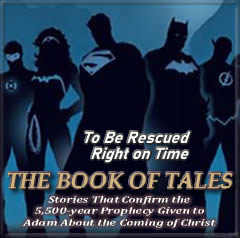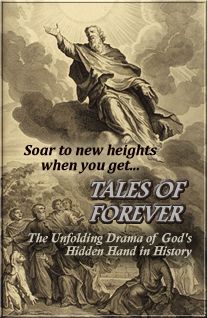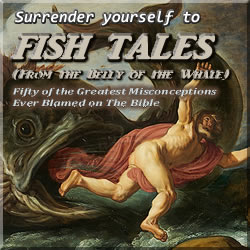A Capstone to Time
One Final Twist
So far this work has chronicled a two-fold drama of paramount importance, to hardcore biblical scholars and casual readers of Scripture alike. The first of these pertains to the little-known prophecy of The Great Five and a Half Days—introduced in The First Book of Adam and Eve, alluded to in The Secrets of Enoch, and finally culminating in The Gospel of Nicodemus. Prior to this work, the scattered bits of this prophetic tapestry lay strewn about like so many disassembled pieces of a puzzle abandoned long ago. But herein they have all been reconnected, and a continuous dramatic narrative has been constructed.
As the story goes: Soon after their tragic expulsion, Adam and Eve were told by God that He intended to allow them back into the garden home they had forfeited; but not until the completion of five and a half “days” from His perspective. Why five and a half days? They were be banished for that length of time because, as Enoch stated in his record of events, Adam and Eve had resided in Eden for five and a half hours. So, just as the Israelites neglected to keep God’s command to let the land lie fallow during His Jubilee years and were consequently exiled, the Lord of Time deigned to establish the prototypical pattern of His judgments in the lives of our first parents and were thereby exiled for five and a half “days.”
Thus, having established the prophetic timeline of The Great Five and a Half Days, the drama came full circle when Pontius Pilate confronted Annas, the chief priest at Jerusalem, who reluctantly confessed that he had also become aware of this promise of “days.” Quite unexpectedly, his investigation of their most sacred text had turned up a startling discovery. In a passage in the first of The Seventy Books, as Annas described it himself, the archangel Michael was said to have told Seth, the third son of Adam, that the Christ was to appear on Earth after 5,500 years. Furthermore, he deduced that because Moses had constructed The Ark of the Covenant with dimensions of five and a half cubits, this doubly confirmed that Christ would come in an ark, or tabernacle, of a body, according to this very same time frame.1
Of course, if you have taken the time to read Tales of Forever for yourself, you might be saying that you already know all this. What you may not be aware of, however, is one last bit of information—“one final twist,” as it were—regarding the prophecy of The Great Five and a Half Days; which leads us to the second drama woven throughout this work, that of Enoch the scribe, who was entrusted with a knowledge of the entire span of human history. Still you may be asking: How can anyone believe that a mere mortal could possibly perceive the history of all mankind—of those who had lived, who were living, and who were yet to live?2 Certainly, it is impossible for anyone to know something so far beyond the pale of human cognition, is it not? Admittedly, such questions are perfectly valid ones, and in our attempt to address such impossibilities, we will offer the following possibilities.
Story Continues Below
Says Richard Price—the founder and CEO of Academia.edu—on his podcast In Depth With Academia:
The Book of Days: In Search of the 5,500-year Prophecy Given to Adam About the Coming of Christ is:
To hear Price’s book review of The Book of Days, CLICK HERE.
To hear Kent and Zen Garcia continue their discussion concerning the implications of the 5,500-year chronology from Adam to Christ as it pertains to the faithfulness of God, CLICK BELOW.
Story Continues From Above
Detectives of History
When grappling with mysteries like this, we have focused on certain key strategies. Primarily, we have centered our investigation upon what I have called the dramas that transcend interpretation. In other words, when faced with the dilemma of what can and cannot be trusted in our search for scriptural truth we—as veritable detectives of history—have focused on events that have been repeated over and over again. In the case of Enoch, history’s most articulate type of Christ, this means we should seek to collect clues that correlate his life and teachings with Jesus, the articulated Word of God, that is to say, the substance of Enoch. In this way, the greater the extent to which we can find parallels between Enoch and Christ, the greater the probability that the improbabilities in question might not seem so improbable after all.
So, what are some of the ways that Enoch, “as shadow,” and Christ, “as substance,” are displayed throughout biblical history? Like Jesus of Nazareth after him, Enoch was anointed with a very special connection with God that provided an acute awareness of the divine presence that no one else possessed. This eventually led Enoch into a one-on-one encounter with God Himself, where the patriarch was given a prophetic message for the sake of the chosen—an event that in many ways foreshadowed the transfiguration of Christ. Upon returning to his family that was convinced he had been killed, Enoch was received by them as one would who had been figuratively brought back from the dead. And finally, having gifted his family with the books he had written, Enoch ascended to Heaven in the sight of everyone, just as Jesus would likewise do after His death and resurrection.
Naturally, because of these striking parallels, skeptics have argued that later authors must have edited the events of Enoch’s life in order to create these connections after the fact, much in the same way they have maligned the prophecies of Daniel because of their unprecedented level of historical accuracy. Of course, much of this criticism falls by the wayside in light of the findings at Qumran, where the contribution of The Dead Sea Scrolls has demonstrated that the books attributed to Enoch preceded the Christian Era by at least two centuries. In this way, one might better appreciate the role that the life of Enoch plays in foreshadowing that of Jesus’, and, considering the relationship between these two miraculous figures, Enoch’s insight into the fate of all mankind.
That said, I would like to return to the point I made earlier in this chapter when I mentioned that you may not be aware of one final bit of information regarding the prophecy of The Great Five and a Half Days. Thus far, in our mystery grappling, we have employed the use of dramas that transcend interpretation. Next, we will turn to another form of examining biblical history, one that is also used because of its ability to nullify the inherent problems that occur with the numerous translations of The Bible. In this case, we will be interpreting the biblical record into terms of another tool, which, like that of the drama, is universal in nature, regardless of culture and/or language, that is to say, mathematics.
But where some would seek to find mathematical messages in Scripture in the form of obscure codes, which may or may not exist, the ones I will be discussing are the kind that are clearly visible, though hidden in plain sight. Moreover, while some would try to expound complicated mathematics that only a genius might hope to appreciate, I will be discussing the kind that even a child can understand. In this case, the mathematics we will be dealing with pertain to one of the most ancient monuments ever dedicated to the knowledge of God—The Great Pyramid of Giza, renowned throughout history as The Pillar of Enoch, due to his reputed role as its architect.
Fear not, however, those of you who have already encountered the stupefying mysteries surrounding this enigmatic structure. We will not be delving too deeply into the multitude of cryptic meanings encased in its marvelous design. No, that, I can assure you, is quite beyond the scope of this particular essay. What we will be looking for, though, is the possible link between Enoch, as architect, and The Great Pyramid, as The Pillar of Enoch. Hopefully, we will establish this link by way of investigating the following questions. Do the allegedly prophetic implications built into the design of The Great Pyramid of Giza reveal a connection to the hidden hand of its supposed architect, Enoch? How might this help to explain the way that this mere mortal could have perceived something as unknowable as the fate of all mankind? And in what ways might the testimony of the alleged “word of God in stone” corroborate the validity of the alleged “word of God by the hand of Enoch”?








